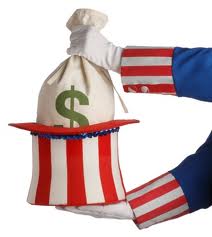 Despite fears of inflation, it’s currently benign no matter how measured. The CPI is up 2.1% year-over-year while the core CPI (which removes food and energy) is up just 1.9%. The PCE, the Fed’s preferred inflation measure, is up 1.6% Y-o-Y with the core up 1.5%. Economy wide inflation is at 1.6% Y-o-Y, and average hourly earnings are up 2% over the past year. Short term rates aren’t rising soon.
Despite fears of inflation, it’s currently benign no matter how measured. The CPI is up 2.1% year-over-year while the core CPI (which removes food and energy) is up just 1.9%. The PCE, the Fed’s preferred inflation measure, is up 1.6% Y-o-Y with the core up 1.5%. Economy wide inflation is at 1.6% Y-o-Y, and average hourly earnings are up 2% over the past year. Short term rates aren’t rising soon.
Tag Archives: federal reserve
Fed Funding
Reading the just released minutes from the most recent Fed meeting, it sounds like when the Fed starts reducing its monthly purchases of $85 billion in treasuries and MBS, the Fed will concurrently announce that it will keep short term interest rates abnormally low for a long time to reassure markets it will continue its very accommodative policies. My take: taper in March, Fed Funds near zero for years.
Fed Funds
While the Fed’s balance sheet has mushroomed from $850 billion in 2008 to $3.3 trillion today as a result of three rounds of quantitative easing, the last of which is not yet done, these holdings bring in considerable amounts of interest. Because the Fed must return all residual earnings to the Treasury, in 2012 the Fed paid Uncle Sam $89 billion! In 2011, it was $77 billion. Long Live QE!
Interesting Jobs
With 195,000 new jobs in June, the average monthly gain in the first half of 2013 is 202,000 – way up from the 130,000/month pace when QE3 began. Moreover, the unemployment rate remained unchanged, because 177,000 people joined the labor force! Unfortunately, 112,000 of the new jobs were either in leisure and hospitality or retail trade, both low-paying sectors. Three more months like this and tapering probably starts in September.
Fractious Fed
With the Fed (and everyone else) forecasting improved economic conditions in the second half of ’13, it’s not surprising that the Fed again reiterated that it MAY start tapering QE3 later this year. Interestingly, the Fed has been consistently over-optimistic when it comes to forecasting. Thus, I still think tapering commences no earlier than November. But, if monthly job creation numbers stay above 183,000/month, tapering could commence in September.
Reserved Federal Reserve
As the economy strengthens, the Fed must begin to end its exceptionally expansionary monetary policy of the last half decade. It will begin by halting its purchases of $85 billion/month in Treasuries and mortgage-backed-securities. Second, it will stop reinvesting interest and principal on its holdings. Third, it will start raising overnight interest rates and lastly it will slowly liquidate its vast holdings of long-term debt. This process will take years.
Inflation to the Rescue
Rather than more quantitative easing, the Fed should stop targeting inflation and instead aim for a consistent level of nominal (unadjusted for inflation) GDP (NGDP) growth over the cycle. With this approach, the Fed would goose NGDP growth when times are bad (like now), by allowing more inflation, but restrain inflation when times are good. This way the Fed can use inflation rather than ignoring it to accomplish its goals.
Currency Clash
When the Fed announces a third round of quantitative easing, expect unintended cross-currency consequences. Last time, the dollar fell against a host of currencies, but now central banks in many of those same countries will actively intervene to prevent their currencies from appreciating against the greenback. However, other countries seem unprepared to intervene such as Australia, New Zealand and South Korea. As a result, bet on their currencies rising.
Money, Money, Money
Given weak job numbers, a slowing world economy, and escalating financial stresses from Europe, the Fed will probably act. Since it can’t buy more long-term Treasuries (it nearly owns them all) or increase the size of its balance sheet (Republicans get angry) it’ll renew Operation Twist, which ends in June. The Fed will sell short term-Treasuries and with the money buy mortgage backed securities to help homeowners and the economy.
Money for Nothing
The Federal Reserve transferred all $76.9 billion of its profit to the Treasury in ’11 down from the record $79.3 billion in ’10. The Fed is profitable because rather than borrowing money, it simply creates what it needs. Thus all interest earned, is profit. The $76.9 billion paid to the Treasury was 3.3% of all revenues! While the Fed has been controversial, having that money returned to the Treasury beats paying it to China.








